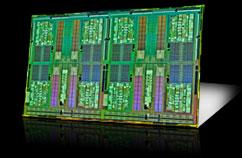 In simplest terms poor sales might be bad news, but in AMD’s case the situation is far more complicated. Computer sales have been down across the board for a number of reasons: The economic climate obviously has had an impact, developments with ARM processors have seen people doing more with less and, dare I say it, there is diminished need for high-performance CPUs. Processing resources are being massively underutilized and have been for a long time. Once, people would buy a new motherboard so that they’d be able to install the latest and greatest CPU, but these days it seems to be the other way around. Most people are looking for functional and efficiency-related improvements more than they want incremental performance gains. While integrated graphics and power efficiency have been an afterthought for most consumers, we can expect them to play a major role in purchasing decisions for the next generation of processors.
In simplest terms poor sales might be bad news, but in AMD’s case the situation is far more complicated. Computer sales have been down across the board for a number of reasons: The economic climate obviously has had an impact, developments with ARM processors have seen people doing more with less and, dare I say it, there is diminished need for high-performance CPUs. Processing resources are being massively underutilized and have been for a long time. Once, people would buy a new motherboard so that they’d be able to install the latest and greatest CPU, but these days it seems to be the other way around. Most people are looking for functional and efficiency-related improvements more than they want incremental performance gains. While integrated graphics and power efficiency have been an afterthought for most consumers, we can expect them to play a major role in purchasing decisions for the next generation of processors.
Will 2013 Be AMD's Time to Shine?
With CPU sales down 30 percent, it would be easy to dismiss 2013 as yet another annus horribilus for AMD. But the next few years present some interesting opportunities for the chipmaker’s floundering CPU division.  In simplest terms poor sales might be bad news, but in AMD’s case the situation is far more complicated. Computer sales have been down across the board for a number of reasons: The economic climate obviously has had an impact, developments with ARM processors have seen people doing more with less and, dare I say it, there is diminished need for high-performance CPUs. Processing resources are being massively underutilized and have been for a long time. Once, people would buy a new motherboard so that they’d be able to install the latest and greatest CPU, but these days it seems to be the other way around. Most people are looking for functional and efficiency-related improvements more than they want incremental performance gains. While integrated graphics and power efficiency have been an afterthought for most consumers, we can expect them to play a major role in purchasing decisions for the next generation of processors.
In simplest terms poor sales might be bad news, but in AMD’s case the situation is far more complicated. Computer sales have been down across the board for a number of reasons: The economic climate obviously has had an impact, developments with ARM processors have seen people doing more with less and, dare I say it, there is diminished need for high-performance CPUs. Processing resources are being massively underutilized and have been for a long time. Once, people would buy a new motherboard so that they’d be able to install the latest and greatest CPU, but these days it seems to be the other way around. Most people are looking for functional and efficiency-related improvements more than they want incremental performance gains. While integrated graphics and power efficiency have been an afterthought for most consumers, we can expect them to play a major role in purchasing decisions for the next generation of processors.
 In simplest terms poor sales might be bad news, but in AMD’s case the situation is far more complicated. Computer sales have been down across the board for a number of reasons: The economic climate obviously has had an impact, developments with ARM processors have seen people doing more with less and, dare I say it, there is diminished need for high-performance CPUs. Processing resources are being massively underutilized and have been for a long time. Once, people would buy a new motherboard so that they’d be able to install the latest and greatest CPU, but these days it seems to be the other way around. Most people are looking for functional and efficiency-related improvements more than they want incremental performance gains. While integrated graphics and power efficiency have been an afterthought for most consumers, we can expect them to play a major role in purchasing decisions for the next generation of processors.
In simplest terms poor sales might be bad news, but in AMD’s case the situation is far more complicated. Computer sales have been down across the board for a number of reasons: The economic climate obviously has had an impact, developments with ARM processors have seen people doing more with less and, dare I say it, there is diminished need for high-performance CPUs. Processing resources are being massively underutilized and have been for a long time. Once, people would buy a new motherboard so that they’d be able to install the latest and greatest CPU, but these days it seems to be the other way around. Most people are looking for functional and efficiency-related improvements more than they want incremental performance gains. While integrated graphics and power efficiency have been an afterthought for most consumers, we can expect them to play a major role in purchasing decisions for the next generation of processors.


